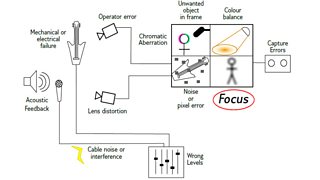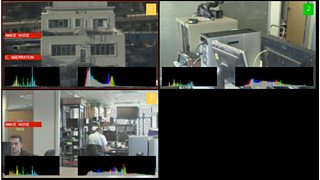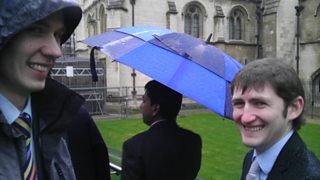QC Live: A quality control production tool for broadcasting
Jonathan McKinnell
Senior Engineer
Tagged with:
My name is Jonathan McKinnell and I work in ΒιΆΉΤΌΕΔ Research & Development (R&D). For more in-depth information about ΒιΆΉΤΌΕΔ R&D as well as White Papers about our research take a look at our .Μύ
One of the challenges facing the ΒιΆΉΤΌΕΔ is the increasing pressure to produce ever increasing volumes of audio and video content for a variety of different platforms (e.g. for television, PC, mobile and tablet) whilst maintaining high quality.
One aspect of this is the technical quality of the content, from noise levels on microphones right through to whether the video is in focus. Fixing these problems when editing content, i.e. after it has already been filmed or recorded, can be expensive or perhaps even impossible, yet spotting all of the errors during the actual production can be very difficult.

An illustration of where typical errors might occur during content capture
In the programme making chain the later these errors get noticed the more it costs to fix them.
In light of this, R&D trainees , Tom Cox and I created a tool toΒ warn production staff of potential problems in a live production environment whilst the content is being initially captured, i.e. during a shoot for TV or a radio recording.
Our prototype tool QC Live warns the user about a variety of potential errors from noisy video or unwanted lens effects (like ), through to feedback on audio, right down to warning if a microphone or video feed is completely dead (even if only for a fraction of a second).
QC Live makes use of Open Source code (called ) incorporating existing academic work on Computer Vision and Signal Processing algorithms whilst also implementing novel algorithms of our own.
One example was an automatic focus detection algorithm which we developed by characterising the statistical properties of video content (inspired by academic work which was originally investigating the cortex of the human eye) and combining this with a technique to spot the blurring of edges in out of focus video.

Our portable studio: a vintage American Airstream trailer
We tested the system with an outside live event using an R&D production lab at a small music festival called which took place in a field in Yorkshire. ToΒ do thisΒ safely for an outside broadcast event we hired a fully kitted out radio trailer which was assembled in a refitted β60s burger van!
The warnings were displayed on a live video where each error was highlighted with a separate message appearing as an overlay on the relevant video feed. A similar live display of the audio errors was shown alongside a graphical visualisation of the peak power of the audio.

Multi-Camera GUI showing addition of the traffic light system
Results from the test shoot highlighted both the importance of having simpler warning indicators and also the advantages of using existing monitoring equipment to display the warnings rather than adding extra displays (which are less likely to be looked at by staff).
We therefore introduced a traffic light based system of warnings overlaid onto the directorβs preview monitor to warn of and summarise any errors occurring during a production.
The traffic light prompts users with a red light when a critical error has occurred (such as a lost feed of video), an amber light when errors which may or may not be critical occur (such as out of focus video) and a green light when all of the quality checks are passed.
You will be able to read more detail about these tests and R&D production labs from my colleague tomorrow.

One of the festival mixing desks with ad hoc labels
Perhaps in future audio warnings could be placed on an audio mixing desk a bit like the makeshift labels above?
We recently presented some of the technical and novel algorithmic aspects of this work in a poster at the governmentβs event at the Houses of Parliament. It was a fun day which amongst other things involved getting absolutely soaked in the security queue whilst desperately fiddling with a broken umbrella!

Mark Glanville and Tom Cox at the Houses of Parliament
In future we will be pursuing further research into the algorithms themselves (via collaboration with Universities) and looking into possible collaboration with third parties with the goal of creating a robust production tool.
If youβve got any questions just let me know and Iβll try and answer them.
is a senior Engineer in ΒιΆΉΤΌΕΔ Research and Development.
You can read more about how the QC Live tool was tested on this follow up .
